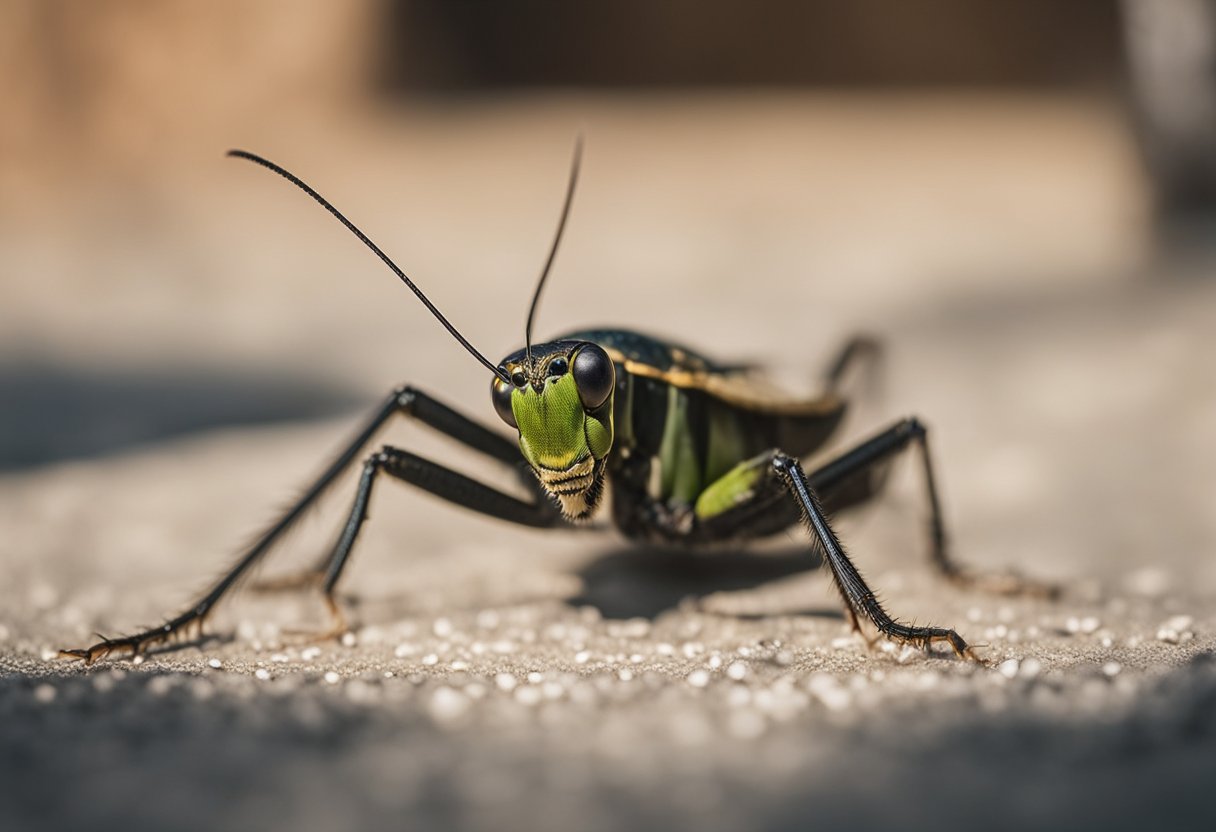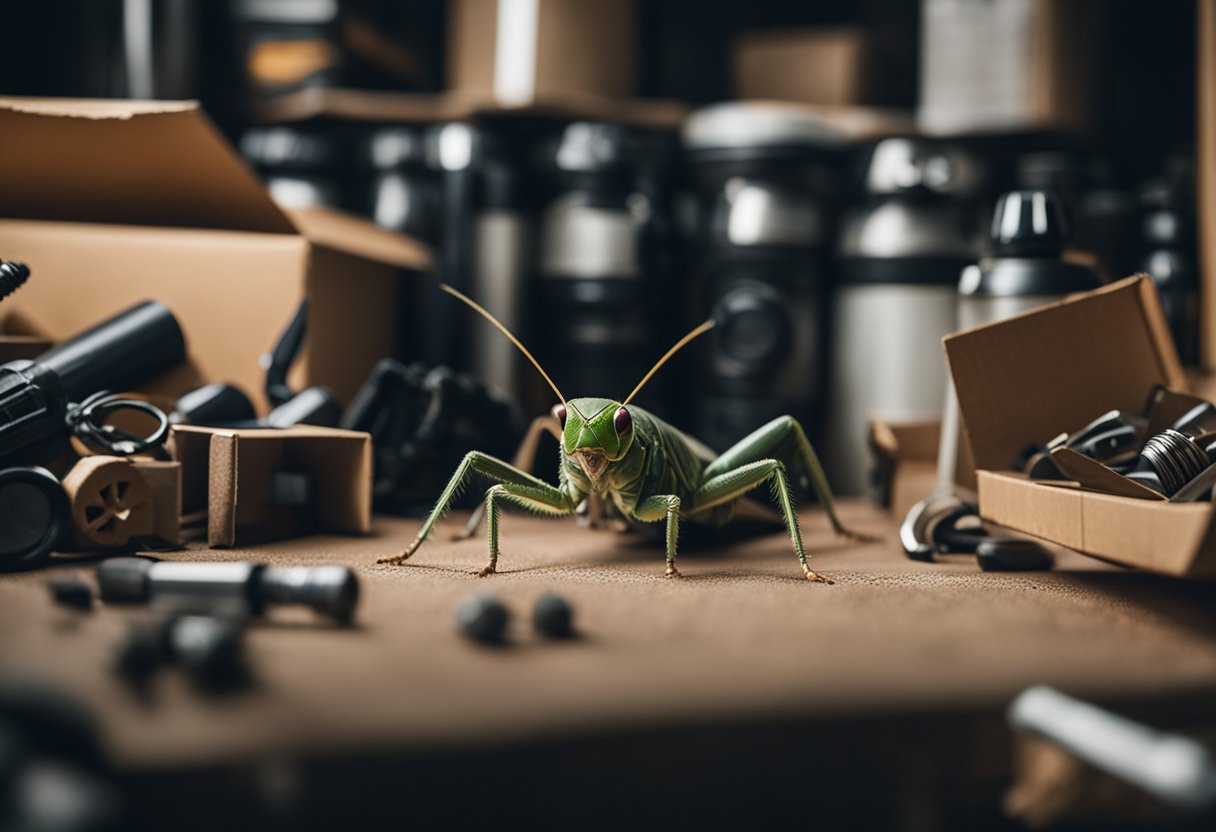Discovering a cricket infestation in your garage can be an irritating issue. The persistent chirping, especially at night, can disrupt the peace of any home. Being nocturnal creatures, crickets are most active after dark, which is when they typically venture into garages in search of warm shelter or to feast on stored items. Identifying the presence of these insects is the first step in dealing with them effectively.

Garages, with their often cluttered spaces and less frequented corners, provide the perfect environment for crickets to hide and breed. These pests are not only a nuisance with their noise but can also cause damage to fabric, paper goods, and even furniture. Understanding the behavior patterns of crickets and their likely hiding spots within the garage is crucial for prompt and effective elimination.
Addressing a cricket infestation necessitates a strategic approach. Meticulous inspection and removal techniques are instrumental in avoiding the proliferation of crickets within the garage, ensuring that the area remains free from these disruptive insects. Consequently, homeowners must arm themselves with knowledge and effective methods to locate and eradicate crickets from their garages.
Understanding Cricket Behavior

To effectively find a cricket in a garage, one must understand their behavioral patterns, which include their life cycle, what attracts them, and their natural predators.
Cricket Life Cycle
House Crickets (Acheta domesticus) and Field Crickets (Gryllus spp.) undergo three main stages during their life cycle: the egg, nymph, and adult stages. The nymphs resemble smaller versions of the adults but lack wings. The complete cycle can range from a couple of months to over a year, heavily influenced by temperature and humidity conditions in their environment. A garage that provides a stable temperature and ample humidity can be an ideal shelter for crickets to mature.
Common Attractants
Crickets are typically drawn to areas where they can find:
- Shelter: Clutter, debris, and stored items in a garage offer excellent hiding spots.
- Temperature: They prefer warm environments, which are found in many garages.
- Humidity: Moist areas, often due to leaks, attract crickets seeking a water source.
- Food Sources: Garages can inadvertently provide access to food in the form of plant matter, fungi, or even other insects.
By eliminating or reducing these attractants, the presence of crickets in a garage can be minimized.
Natural Predators
Crickets have a variety of natural predators that can help in controlling their population. These include:
- Amphibians: Such as frogs and toads.
- Reptiles: Like lizards and small snakes.
- Birds: Various species that may venture into open garages in search for food.
- Insects: Spiders and parasitic wasps also predate on crickets.
Incorporating these predators into the environment, or mimicking their presence, can be useful in managing cricket populations. However, it is important to consider the viability and consequences of introducing predators into a home setting.
Identifying Cricket Presence
Before engaging in eradication measures, it’s essential to confirm a cricket infestation within a garage, primarily detected through physical signs and distinctive sound patterns.
Signs of Infestation
In a garage, one can identify a cricket infestation by observing specific indicators. These include:
- Physical Evidence: Spotting crickets themselves, small, dark-colored insects, with field crickets typically larger and house crickets smaller and light brown, is a telltale sign.
- Droppings: Crickets leave behind droppings, which are small and black, resembling black pepper grains.
- Damage: They may gnaw on fabrics, papers, or plants, so look for unexplained damage in these items.
- Clutter and Hiding Spots: Crickets seek out warm, moist environments. They often reside in cluttered areas or among piled-up items where they can hide undisturbed.
Chirping and Locations
The recognizable chirping noise primarily made by male crickets can guide one to their location:
- Chirping Sound: The constant, high-pitched chirping is most active at night and can help pinpoint the cricket’s location.
- Tracking: Listen for variations in chirping volumes to locate their hiding spots. Louder chirping indicates closer proximity to the cricket’s position.
By carefully listening and noting these factors, one can accurately detect the presence of crickets and their specific dwelling areas within a garage.
Preventing Cricket Entry
To keep crickets from infesting a garage, one must focus on eliminating access and reducing factors that attract them.
Sealing Entry Points
Cracks, gaps, and holes in the garage should be meticulously sealed to deny crickets entry. Windows and doors prove to be common ingress points for these insects. For doors, weatherstripping is an essential measure to ensure tight seals. Use of caulking can effectively close off smaller openings around window frames and utilities entering the garage. Homeowners should routinely inspect and repair these barriers to prevent future infestations.
Actionable Steps:
- Inspect: Regularly check for openings around doors, windows, and garage foundations.
- Seal: Use caulk for minor gaps and weatherstripping for doors and windows.
- Repair: Fix or replace any damaged screens, weatherstripping, or seals immediately.
Reducing Attraction Factors
Eliminating factors that attract crickets is key in prevention. Crickets are drawn to warm, moist environments, so maintaining a dry garage is crucial. Items should be stored in sealed containers rather than cardboard boxes which can provide both harborage and a food source for crickets. Outdoor lighting can also attract crickets; thus, positioning lights away from the garage or opting for yellow bulbs which are less attractive to insects can help.
Recommendations:
- Storage: Use airtight, plastic storage containers to deter crickets from nesting and feasting.
- Moisture Control: Reduce humidity with dehumidifiers or proper ventilation.
- Lighting: Implement the use of yellow outdoor bulbs and keep lights directed away from the garage.
Non-Toxic Removal Methods
In seeking to eliminate crickets from a garage, homeowners can employ a variety of non-toxic and environmentally-friendly methods. These tactics can be just as effective as chemical alternatives, but without the associated risks.

DIY Traps and Baits
One can create DIY traps using common household items. An effective trap involves using molasses as bait. Here is a simple method:
- Fill a shallow bowl with a mixture of molasses and water. The sweetness of the molasses attracts the crickets, while the sticky consistency ensnares them.
- Place the bowl in areas where cricket activity is high.
Glue traps serve as another option:
- Spread a thin layer of non-toxic glue on a piece of cardboard.
- Sprinkle a small amount of sugar to lure crickets onto these glue boards.
- Position these traps along paths where crickets are likely to travel.
Natural Repellents
For those who prefer to keep crickets at bay rather than trapping them, several natural repellents can be useful:
- Vinegar, diluted with water, can be sprayed around the garage. The strong odor is unappealing to crickets and can deter their presence.
- A dehumidifier can reduce moisture levels in the garage, creating an environment that is less inviting to crickets, as they thrive in humid conditions.
Essential oils, such as peppermint oil, can act as repellents:
- Add a few drops of peppermint oil to a spray bottle filled with water.
- Spray the solution around the garage to create a scent barrier that crickets dislike.
Chemical and Professional Solutions

In tackling a cricket infestation in the garage, homeowners have the option of using various insecticides or seeking assistance from professional pest control services.
Insecticide Use
Insecticides offer a direct approach to cricket extermination. Homeowners can apply bug sprays that contain chemicals designed to target crickets. These sprays are often applied along the garage’s perimeter where crickets are known to enter or hide. For a more persistent problem, boric acid can be effective. This substance can be sprinkled in powder form into corners and along walls, as it works to poison crickets upon ingestion.
Another method involves the use of glue traps. These can be strategically placed where cricket activity is high. The sticky surface of the glue traps will immobilize crickets, reducing the population over time. Due to their chemical nature, it’s imperative to use all insecticides according to the manufacturer’s instructions to ensure safety for both humans and pets.
Hiring Pest Control Services
For cricket infestations that are extensive or difficult to manage, hiring professional pest control services like Orkin may be the best solution. Professionals bring the expertise to thoroughly assess the cricket problem and devise a tailored treatment plan. This often includes the identification of entry points, advice on prevention, and sometimes the use of commercial-grade insecticides not available to the general public. Regular service schedules can ensure that cricket problems do not reoccur, providing peace of mind to homeowners.

